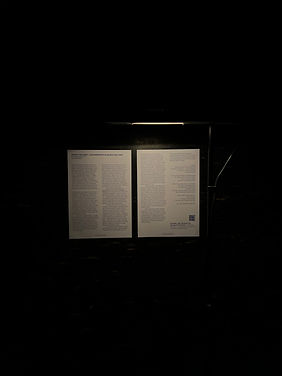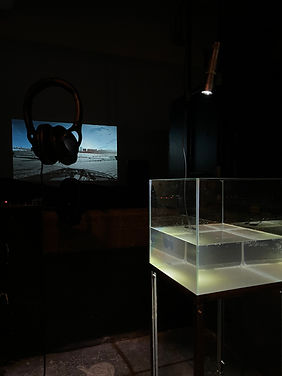


beneath the waves - a documentation of aquatic field trips
audiovisual installation 12’
05. - 08.06.2025
West, Den Haag
This sound installation shows three of the field trips (locations) that were central to my artistic research about anthropogenic underwater noise pollution: the Port of Rotterdam, the offshore wind farm called Westermeerwind in the IJsselmeer, and the Zeeland region, recorded while sailing on the light observatory #7 or during stops at several locations (e.g. recordings of marinas by night, Tiengemeten Island). The installation offers an experience to listen closely to these aquatic environments, smell the seawater, and observe the wonderful pictures and the video on the dinghy boat of Fabio Meinardi who was documenting 2/3 trips with his lens.
Anthropogenic underwater noise pollution is a largely overlooked form of environmental disruption – one that literally remains beneath the surface. We can't see it, we can't feel it – and we aren’t normally present in the environment that it occurs. Marine organisms rely heavily on sound for orientation, navigation, communication, and survival. Increasing noise levels from human activities interfere with these vital behaviors and can have acute, chronic, or cumulative effects on marine life and plants, from the smallest to the biggest organism. In some cases, the consequences are fatal.
This issue is not peripheral – it is deeply connected to broader ecological systems on which we depend. Oceans produce over 50% of the oxygen we breathe, primarily through marine photosynthesizers such as phytoplankton and seaweed. Yet our industrial activity increasingly alters their acoustic environments. Recognising and responding to the sonic dimensions of this ecological crisis is essential.
My motivation for this research grew from a long-standing interest in acoustic ecology, which developed during my bachelor studies, and from a deeply personal connection to water. Growing up near Lake Constance, and with a mother who worked as a swimming instructor, I spent much of my childhood immersed in water. This connection may also have contributed to my hearing loss in my right ear, triggered by a perforation in the eardrum, which was diagnosed and partially corrected at age 18. Since then, my sensitivity to sound and noise in different environments has only deepened.
During my time working with the interdisciplinary art collective Biotop der Relevanz, which focused on the health of the underwater ecosystem, I began to shift my attention specifically to the sonic dimension of it. I postponed developing this idea during my bachelor studies due to the fast-paced nature of the program, and because I felt the topic demanded more time for research, reflection, and creative development.
This research explores how field recordings of anthropogenic underwater noise can serve as the basis for artistic compositions and live performances to reveal the unknown and raise awareness. Through engaging with scientific studies, conducting fieldwork in aquatic environments, practicing mindful listening, and experimenting musically – both independently and with collaborators - I develop a form of artistic language. While the research is grounded in sound and practice, it has also unfolded as a deeply personal and aesthetic inquiry.
As I worked with this material over the past two years, an aesthetic dilemma began to surface. I found myself deeply drawn to the sonic qualities of noise pollution – fascinated by its textures and potential, especially as someone who appreciates noise music. Yet I was constantly aware of the environmental harm it represents. It was difficult to reconcile my artistic curiosity with the ethical weight of the subject. This tension – between creative fascination and ecological responsibility – challenged me to critically examine my own position. Engaging in this long-awaited research meant a great deal to me, not only intellectually, but also personally. Having relearned how to listen with both ears, I’ve become intimately aware of how overwhelming and painful the sonic environment can be. This personal journey has deepened my understanding of how listening can be both an experience of beauty and a reminder of harm.
These experiences have led me to a series of questions that guide my artistic exploration: How can underwater noise pollution be transformed into meaningful sonic or artistic material without aestheticizing ecological harm? How do we feel while listening to anthropogenic underwater noise pollution? How can I create a listening experience for the listener to make the essence of my research more clear? How can I evoke specific feelings like discomfort and urgency through my artistic practice? In what ways can sound art contribute to a critical understanding of human impact?
These questions form the conceptual backbone of the thesis and have shaped each stage of the research process – from listening and recording to composing and performing. To engage meaningfully with the material, it was essential to understand where this noise comes from and what it represents in a broader ecological and political context.